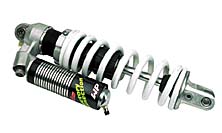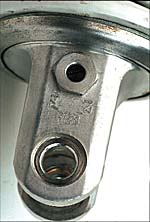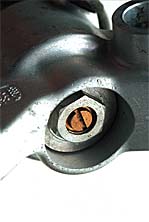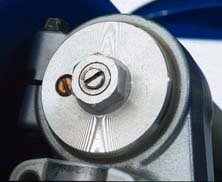SUSPENSION TECH
HOW YOUR SHOCK WORKS
And how to work with it
Confused by all the clickers and dials on your fancy new shock absorber? Join the club. In surveys conducted by the technical department of a major motorcycle manufacturer, it was discovered that only a small percentage of owners actually know what the clickers do. Here is MXA’s primer on how your shock works (and what to do about it).
SHOCK SPRING PRELOAD
By turning the preload ring, the race sag can be set at 100mm (measured with the rider on board). Once the spring is adjusted to the proper race sag, the free sag needs to be checked. Free sag is measured with the rider off the bike. It is the amount of upward movement that the frame has when the bike is sitting on the ground. If free sag is less than 15mm or more than 35mm, the spring rate is incorrect.
REBOUND
Rebound damping controls how quickly the shock returns to its fully extended position after hitting a bump. If the rebound is too fast, the rear of the bike will dribble like a basketball. If the rebound damping is too slow, the rear of the bike will not return fully before the next bump is hit (this is called packing).
Turning the rebound screw in (clockwise) slows the rebound down. Turning it out speeds up the rebound. If the rear wheel kicks straight up over square-edge bumps, it normally means that the rebound damping is too fast. If the rear wheel thuds through square-edge bumps, the rebound damping is probably too slow. Increasing rebound damping will also increase compression damping to a small degree.
LOW-SPEED COMPRESSION
Low-speed compression is adjusted by a flat-bladed screwdriver and is measured in clicks out from all the way in. Low shock shaft speeds are generated by rolling whoops, landings from tabletops and most jumps.
Turning the low-speed compression adjuster in will make the shock stiffer, while turning it out will make it softer. The range of adjustment can vary by brand but normally goes from one click out to 25 clicks out.
HIGH-SPEED COMPRESSION
On most modern shocks, the high-speed compression dial is a large hex-headed dial that measures its adjustment by full turns. Don’t confuse high-speed compression with the speed of the motorcycle. The term refers to the speed of the shock shaft. High shock shaft speeds come from square-edge bumps, slap-down landings and the tops of whoops.
Turning the high-speed compression clicker in will increase the damping (and allow the rear of the bike to ride higher), while turning the hex-headed dial out softens the compression damping and lowers the ride height of the rear end.
HOW YOUR FORKS WORK
And how to work with them
Unlike a shock absorber, a motorcycle fork is relatively easy to tune at home. Modern motocross forks have four do-it-yourself tuning possibilities:
(1) Compression damping-controlled by a clicker.
(2) Rebound damping-controlled by a clicker.
(3) Spring rate-adjusted by changing springs.
(4) Oil height-controlled by adding or subtracting fork oil.
Once you understand how forks work, you are on your way
to being a tuning expert.
FORK SPRING RATE
Most production motorcycles come with fairly high oil heights and soft spring rates. This is a marketing ploy to allow one set of forks to work for both small and large riders. Serious racers need to select the correct fork springs for their riding styles and track conditions.
As a rule of thumb, if you are forced to turn the compression clicker all the way in to stop the bike from bottoming, you need stiffer fork springs. Only the smallest of riders will ever need lighter fork springs.
REBOUND
Rebound damping controls how quickly the fork returns to its fully extended position after hitting a bump. If the rebound damping is too light, the fork will snap back quickly and cause the front end to porpoise across rough ground. If the rebound damping is too soft, the fork will pack because it will not have had enough time to return to its full stroke.
Turning the rebound screw in (clockwise) slows the rebound, while turning it out speeds up the rebound. Kayaba and WP forks have the rebound adjuster on the top of the fork leg. Showa forks, which are found on the CR250 and RM125, have the rebound adjuster on the bottom.
OIL HEIGHT
Motorcycle forks are filled with oil. The oil not only lubricates the internals and meters the damping via its viscous nature, but it also creates a trapped air space at the top of the fork tubes. Since motorcycle forks are not completely full of oil, the air space acts as a secondary spring. As the fork moves upward in its stroke, the air pocket is compressed. This compressed air acts like a spring to resist bottoming. By changing the height of the oil in the forks, a tuner can control how stiff the air spring will be and when it will start to take effect.
High oil heights will stop a fork from bottoming, but make it harsher in the midstroke. Low oil heights will be fluid through the midstroke, but prone to bottoming. The goal is to choose an oil height that is the perfect mix of both.
Oil height is measured in millimeters from the surface of the oil to the top of the fork leg (with the springs out and fork collapsed).
COMPRESSION
The compression clicker on
Kayaba and WP forks is found at the bottom of the fork leg (on Showa forks it is on the top). Turning the flat-bladed screwdriver slot inward (clockwise) makes the forks stiffer, and vice versa. It should be noted that the compression adjuster effects the travel from midstroke on. If your forks are bottoming, you should turn the clicker in. If the forks aren’t getting full travel, turn the compression clicker out. If, however, your forks feel harsh in the first half of the stroke, the compression clicker will not make much difference. o




Comments are closed.